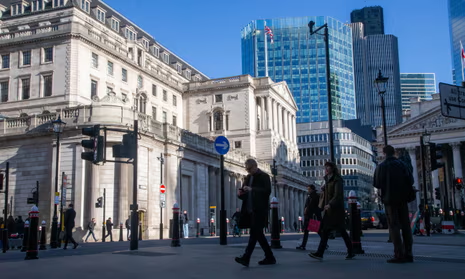The Bank of England (BoE) has issued a stark warning about significant economic risks that could impact the UK in the coming months. Despite growing expectations for interest rate cuts, the central bank has made it clear that monetary policy easing is not imminent. Factors such as global trade tensions, persistent inflation, and a weakening UK economic outlook have led policymakers to take a cautious stance on rate adjustments.
Global Trade Tensions and Economic Uncertainty
One of the major risks highlighted by BoE Governor Andrew Bailey is the ongoing trade tensions, particularly the recent U.S. tariffs imposed on key trading partners like China, Mexico, and Canada. These trade disputes have the potential to disrupt global supply chains and slow economic growth, both in the UK and internationally.
Bailey has urged global leaders to seek diplomatic resolutions rather than unilateral trade measures that could trigger economic instability. “We are in a delicate position where external factors, particularly trade policies from major economies, are influencing the UK’s financial stability,” he stated.

Inflation Pressures Keep Rate Cuts on Hold
Despite a recent quarter-point reduction in the Bank Rate to 4.5%, the BoE remains hesitant to move forward with further cuts. Inflationary pressures persist, making it difficult for policymakers to justify additional rate reductions in the near term.
Sir Dave Ramsden, Deputy Governor of the BoE, emphasized the challenge of balancing inflation control with economic growth. “We are in an environment where wage growth, changes in fiscal policy, and external trade conditions all add layers of complexity to monetary policy decisions,” he explained.
A key concern is the recent introduction of higher national insurance contributions and an increased national living wage, both of which could affect the labor market and drive inflation higher. These factors have led the BoE to adopt a “gradual and careful” approach to interest rate decisions.
UK Growth Forecast Slashed
Adding to concerns, the BoE has revised its UK GDP growth projection downward for the year. Initially forecasted at 1.5%, the growth outlook has now been reduced to 0.75%. This downward revision is a significant setback for the government’s ambitions to stimulate economic expansion.
Treasury Chief Rachel Reeves acknowledged the BoE’s decision to hold off on rate cuts but stressed the importance of accelerating growth initiatives. “We need to ensure that businesses and households feel supported while keeping inflation under control,” she remarked.
What This Means for Consumers and Businesses
For consumers and businesses, the decision to maintain interest rates means that borrowing costs will remain higher for longer. Mortgage rates, personal loans, and credit card interest rates are unlikely to see reductions in the immediate future.
However, the BoE has indicated that if inflation shows sustained downward movement, rate cuts could be considered later in 2025. The Monetary Policy Committee (MPC) remains divided on this issue, with some members advocating for a more aggressive rate reduction strategy to boost economic activity.

Next Steps for the Bank of England
Looking ahead, the BoE will closely monitor:
- Inflation trends and their impact on household purchasing power.
- Global trade policies and potential disruptions to supply chains.
- Labor market dynamics, including wage growth and employment rates.
- Geopolitical factors, particularly how US policies affect international markets.
Given the uncertain outlook, policymakers have emphasized the importance of data-driven decisions, ensuring that future interest rate changes align with economic realities rather than market speculation.
Final Thoughts
The Bank of England’s decision to keep interest rates steady reflects the complexity of the current economic environment. With persistent inflation, global trade uncertainties, and a sluggish growth outlook, policymakers are taking a measured approach to monetary policy.
For UK businesses and households, this means continued economic challenges, particularly in borrowing costs and price stability. While rate cuts may be on the horizon, they will only materialize when inflationary pressures ease and economic stability improves.
To stay informed on interest rates and monetary policy updates, visit:
- Bank of England Official Site: www.bankofengland.co.uk
- UK Inflation Reports: www.ons.gov.uk
- Government Economic Forecasts
- Global Trade Analysis: www.wto.org
As the situation evolves, businesses and individuals should remain prepared for a longer period of high interest rates before any monetary easing takes effect.
This article has been carefully fact-checked by our editorial team to ensure accuracy and eliminate any misleading information. We are committed to maintaining the highest standards of integrity in our content.

A senior at Yale-NUS College with interests in developmental and labour economics, as well as creative non-fiction and poetry. Currently, I’m studying as an Economics major and an Arts and Humanities minor (focusing on Creative Writing) with heavy involvement in the Singaporean journalism scene and involved in research on economic history and educational policy. I’m working as an author for SKC News, Yale-NUS’ student publication, as a writer for Wingspan, Yale-NUS’ alumni magazine, and as a tutor for the NUS Libraries Writer’s Centre. | Linkedin



